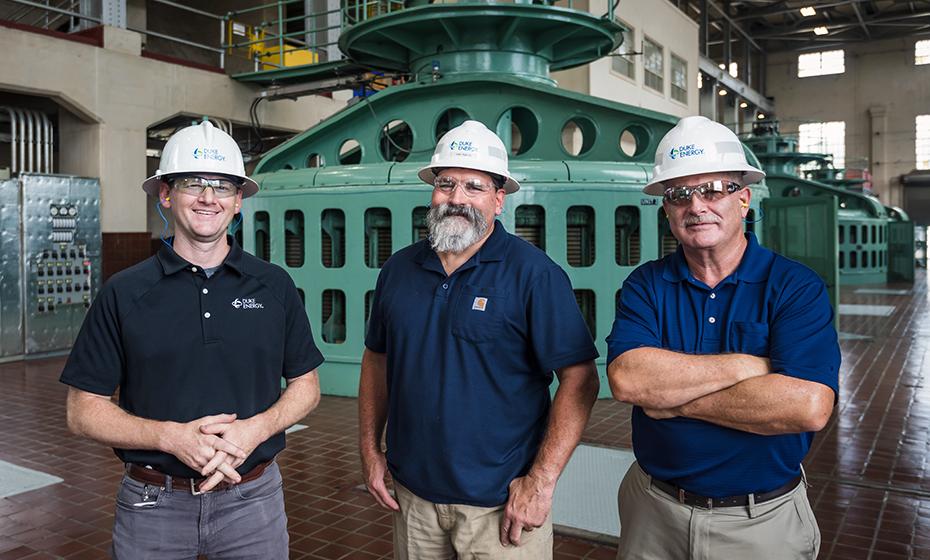Duke Energy's Mountain Island Hydro Marks 100 Years of Producing Clean Energy
Centennial celebration: Duke Energy's Mountain Island Hydro Station provides clean, renewable energy to the Charlotte, N.C., area
Published 10-06-23
Submitted by Duke Energy

In 1923, Calvin Coolidge was sworn in as the country’s 30th President, Ford Motor Co. was producing roughly 10,000 Model Ts a day and North Carolina had just surpassed Massachusetts as the nation’s leading textile producer.
Across the state, hundreds of textile mills employed tens of thousands of workers. This production boom relied on one thing: electricity.
To meet the demands, Catawba Manufacturing & Electric Power Co., a subsidiary of Southern Power Co., built a powerhouse and dam on the Catawba River, the Mountain Island Hydro Station in Gaston County, near Charlotte, N.C.
A century later, the station’s four units still provide power, and the lake provides drinking water and recreation resources for hundreds of thousands of North Carolina and South Carolina residents.
“This was the first river in the United States that was comprehensively planned and developed for electric power generation,” said Jeff Lineberger, general manager of Water Strategy, Hydro Licensing and Lake Services for Duke Energy. “The founders of our company had this vision way back at the turn of the last century to build a series of linked hydropower stations on a river.”
Mountain Island Lake was the eighth of 11 manmade lakes created in the Catawba-Wateree river system. Its objective was to provide electricity to factories, primarily the textile and furniture manufacturing industries. “They were looking to provide an economical electric generation source to power those factories to help this part of the country recover from the Civil War.”
James B. Duke, Gill Wylie and William States Lee moved the economy in the Carolinas from agrarian to industrial.
“They wanted to give people a place to work that was off the farm and to really change the economy,” Lineberger said. “It absolutely has done that. Charlotte and the region would not be what they are now without this 11-lake system.”

Today, Mountain Island Hydro Station provides 68 megawatts of clean, responsive power.
“We utilize this facility to help provide generation at the peak load of the day,” said Hydro Operations Manager Trevor Turner. "For the Carolinas, the winter peak load is in the morning, and the evening in the summer. We can also start quickly during emergency situations when the grid demands additional generation.”
The Duke Energy hydro fleet was among some of the first in the country to implement remote operations, technology Duke Energy helped pioneer in the 1990s and early 2000s, Turner said.
The station is operated by the Regulated Renewables Operation Center, or RROC, a technology change that increased safety and efficiency.
Not only a reliable energy source, Mountain Island Lake, which was formed by the dam, is the primary source of drinking water for more than 1 million residents in Charlotte, Gastonia and Mount Holly. Before it, Charlotte got its drinking water from the Catawba River.
“It’s one of the most important lakes in the state of North Carolina from a public water-supply standpoint,” Lineberger said.
While historic, the station also serves a timely role, as part of the company’s clean energy transition to achieve net-zero methane emissions from natural gas by 2030 and net-zero carbon emissions from electricity generation by 2050.
By producing hydropower, a clean and renewable resource, Mountain Island Hydro Station’s output helps Duke Energy work toward that goal.
With 96.5 miles of shoreline – and over a third of it protected – Mountain Island Lake is also an important wildlife habitat. Latta Place Historic Site, Rural Hill and the Cowans Ford Wildlife Refuge, which the Audubon Society of North Carolina has designated as an important bird area, are along its shores.
Mountain Island Lake also provides public recreational opportunities, like boating and fishing. Duke Energy maintains four boating access areas on the lake, plus a bank fishing platform downstream of the hydro station. Plans are in the works to add a swim beach and bank fishing area on the lake near Mount Holly.
In addition to canoe and kayak launch site, the Lucia Access Area has a spot where visitors can view wildlife.
View original content here.




Duke Energy
Duke Energy
Duke Energy (NYSE: DUK), a Fortune 150 company headquartered in Charlotte, N.C., is one of America’s largest energy holding companies. The company’s electric utilities serve 8.4 million customers in North Carolina, South Carolina, Florida, Indiana, Ohio and Kentucky, and collectively own 54,800 megawatts of energy capacity. Its natural gas utilities serve 1.7 million customers in North Carolina, South Carolina, Tennessee, Ohio and Kentucky.
Duke Energy is executing an ambitious energy transition, keeping customer reliability and value at the forefront as it builds a smarter energy future. The company is investing in major electric grid upgrades and cleaner generation, including natural gas, nuclear, renewables and energy storage.
More information is available at duke-energy.com and the Duke Energy News Center. Follow Duke Energy on X, LinkedIn, Instagram and Facebook, and visit illumination for stories about the people and innovations powering our energy transition.
More from Duke Energy

